When the colder months roll in, a fresh, hearty salad is just what you need to brighten your table. The Winter Cobb Salad is a delightful seasonal spin on the beloved classic, bringing together rich, comforting flavors with fresh, winter-inspired ingredients. This article will take you through the origins of the Cobb salad, highlight its seasonal transformations, and guide you in preparing a mouthwatering dish that’s as beautiful as it is delicious. Plus, you’ll learn how to customize it for different diets and preferences. Let’s dig in!
Introduction to the Winter Cobb Salad
The History Behind the Classic Cobb Salad
The Cobb salad has a charming history, believed to have been created in the 1930s at the Brown Derby restaurant in Los Angeles. It’s said that Robert Cobb, the restaurant owner, whipped it up late at night from leftovers in the kitchen. The dish became an instant hit, known for its signature combination of leafy greens, chicken, eggs, avocado, and blue cheese.
Why the Winter Cobb Salad is Perfect for Seasonal Dining
While the original Cobb salad is timeless, its beauty lies in its versatility. For winter, this classic is transformed with seasonal produce, offering a fresh way to enjoy hearty, nutritious ingredients during the colder months. Think earthy roasted vegetables like butternut squash and beets, crisp greens such as kale, and sweet bursts of fruit like pomegranate seeds and pears. By leaning into what’s in season, you not only enjoy peak flavors but also support local and sustainable eating.
Essential Ingredients for a Winter Cobb Salad
Leafy Greens Leafy Greens for Your Winter Cobb SaladSelection
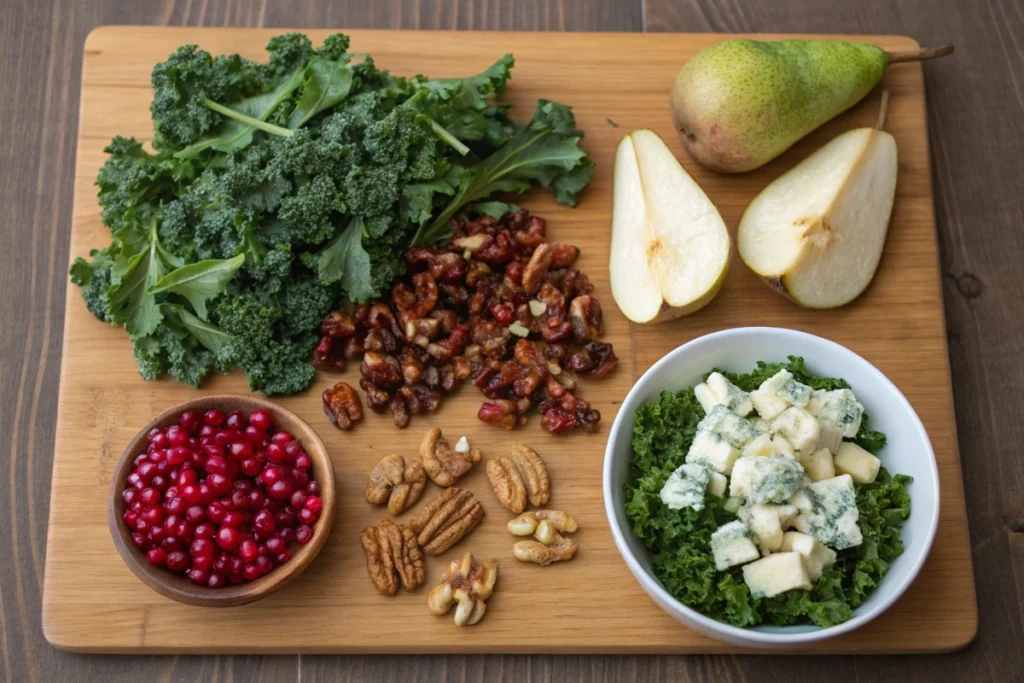
The foundation of any great salad is the greens, and the Winter Cobb Salad is no exception. During the colder months, robust greens like kale, spinach, and arugula take center stage. These greens aren’t just full of flavor—they’re also packed with nutrients like vitamin C and iron to help you stay healthy through winter. For added texture, try mixing in crunchy romaine or tender baby greens. Together, these create a sturdy base that complements the heartier toppings.
Proteins to Make Your Salad Heartier
A key feature of any Cobb salad is its protein. For a winter-inspired twist, roasted chicken is an excellent choice—it’s juicy, savory, and easy to prepare. If you’re looking for something plant-based, tofu or tempeh can be seasoned and baked to add a flavorful punch. Hard-boiled eggs are another staple, bringing richness and balance to the dish. With these options, you can ensure your salad is satisfying enough to be a full meal.
Seasonal Vegetables to Elevate Your Cobb Salad
Winter vegetables are what truly set this Cobb salad apart. Roasted butternut squash adds a touch of sweetness and a creamy texture, while earthy beets provide a pop of color. Brussels sprouts, either roasted or shaved raw, bring a slightly nutty flavor. These seasonal picks don’t just look stunning—they also pack in a host of vitamins and antioxidants.
Fruits and Nuts: Sweet and Crunchy Additions
No Winter Cobb Salad is complete without some fruit and nut toppings. Pomegranate seeds offer a burst of tartness and a festive touch, while sliced pears or apples bring natural sweetness. To add crunch, sprinkle on walnuts or pecans. These elements elevate the salad, making it feel both luxurious and cozy.
Cheese Choices for the Perfect Winter Salad
Finally, let’s talk cheese! The classic Cobb salad uses blue cheese, and it’s a fantastic choice for winter, too. Its bold flavor pairs perfectly with the sweetness of the fruit and the earthiness of the vegetables. For a milder option, try feta or creamy goat cheese. Whichever you choose, cheese brings richness and depth to the salad.
Preparing the Components
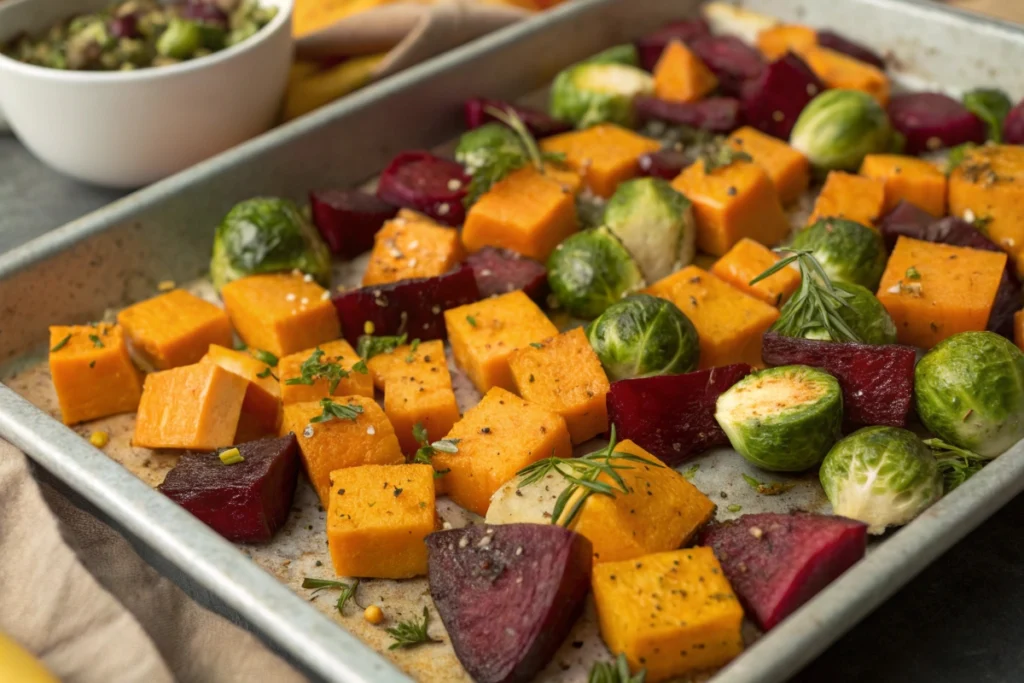
Roasting Vegetables for Your Winter Cobb Salad
To make your Winter Cobb Salad shine, start by roasting the vegetables. Dice the butternut squash and beets into bite-sized pieces, drizzle them with olive oil, and season with salt, pepper, and a pinch of cinnamon or nutmeg for warmth. Roast them at 400°F (200°C) until they’re golden and tender. This step not only enhances their natural sweetness but also gives the salad a hearty, comforting vibe.
Cooking Proteins: Chicken, Tofu, or Tempeh
Next, focus on your protein. For roasted chicken, season the meat with garlic powder, paprika, salt, and pepper, then bake it until it’s juicy and flavorful. If you’re using tofu, press it to remove excess moisture, then marinate it in soy sauce, maple syrup, and a touch of smoked paprika before baking. Hard-boiled eggs are a quick addition—just boil them for 10 minutes, peel, and slice.
Prepping Fresh Ingredients for a Seasonal Cobb Salad
While your veggies and proteins are cooking, prepare the fresh ingredients. Wash and dry your greens, slice the fruits thinly, and crumble your chosen cheese. Toast the nuts lightly in a dry skillet to bring out their natural oils and deepen their flavor. These fresh elements add brightness and balance to the heartier roasted components.
Crafting the Perfect Dressing
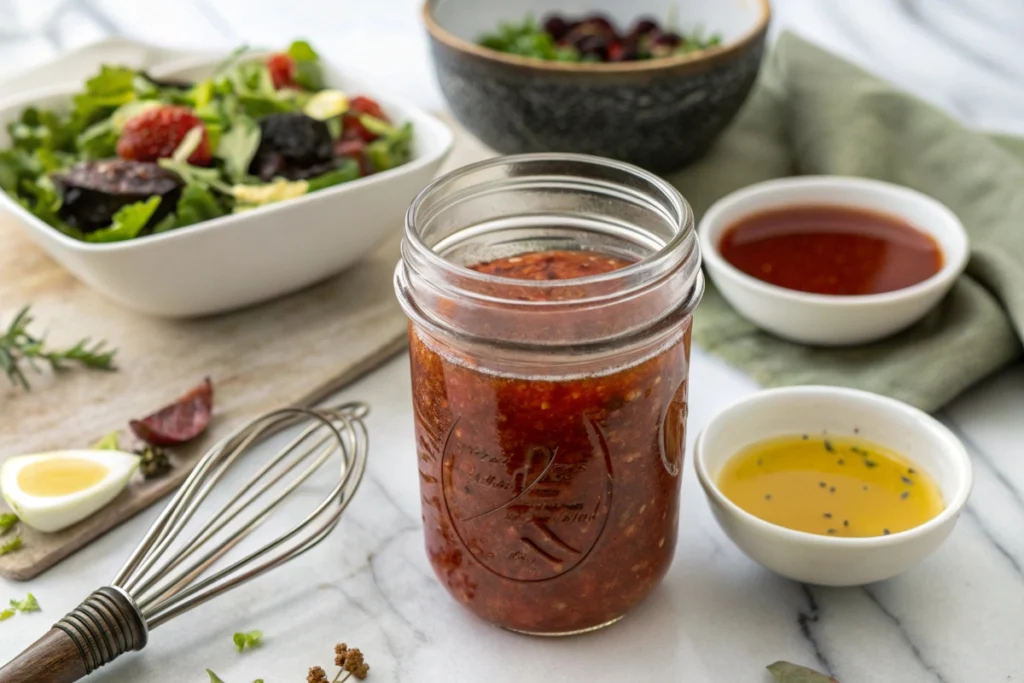
Classic Red Wine Vinaigrette for Your Winter Cobb Salad
A classic red wine vinaigrette is a timeless choice for dressing a Winter Cobb Salad. To make it, whisk together red wine vinegar, Dijon mustard, minced garlic, salt, and pepper. Gradually add olive oil while continuing to whisk until the mixture emulsifies. This tangy dressing complements the rich flavors of roasted vegetables and hearty greens, adding a zesty note that ties the salad together.
Warm Herb and Garlic Dressing
For a cozy and savory touch to your Winter Cobb Salad, you can make a warm herb and garlic dressing. Start by heating olive oil in a small pan over medium heat. Add finely minced garlic and sauté it until it becomes fragrant and golden. Next, toss in freshly chopped herbs like rosemary, thyme, or parsley for a burst of flavor. To balance the dressing, mix in a splash of apple cider vinegar and a drizzle of honey or maple syrup. Stir everything together until well combined and warmed through.
This dressing adds a comforting warmth and a deep, earthy flavor to your salad, perfectly complementing the roasted vegetables and fresh toppings. It’s an excellent alternative to traditional dressings while keeping the dish vibrant and healthy..
Citrus-Based Dressing: A Zesty Addition to Your Salad
If you prefer a lighter, more refreshing dressing, a citrus-based option can brighten up the Winter Cobb Salad. Combine freshly squeezed orange or lemon juice with a bit of honey, minced shallots, and a pinch of salt. Slowly whisk in olive oil until the dressing is well blended. The citrus notes provide a lively contrast to the earthy roasted vegetables and robust greens, making the salad feel lighter and more vibrant.
Assembling the Winter Cobb Salad
Layering Techniques
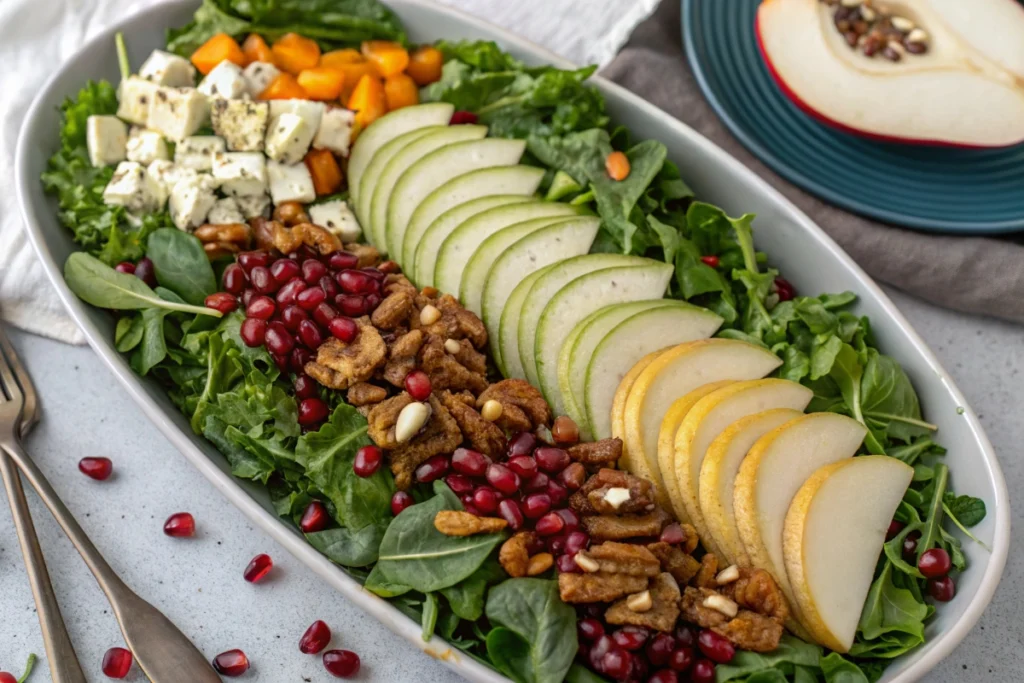
To assemble your Winter Cobb Salad, start with a generous base of your chosen greens, such as kale and spinach, arranged evenly on a large platter or individual plates. Next, artfully arrange the roasted butternut squash, beets, and Brussels sprouts in sections atop the greens. Place the sliced roasted chicken or alternative protein in another section, followed by the hard-boiled egg slices. Continue by adding the fresh elements: arrange the sliced pears or apples, sprinkle the pomegranate seeds, and scatter the toasted nuts. Finally, add crumbles of your selected cheese over the top. This method of grouping ingredients not only creates a visually appealing presentation but also allows each component to shine.
Serving Suggestions for Your Seasonal Cobb Salad
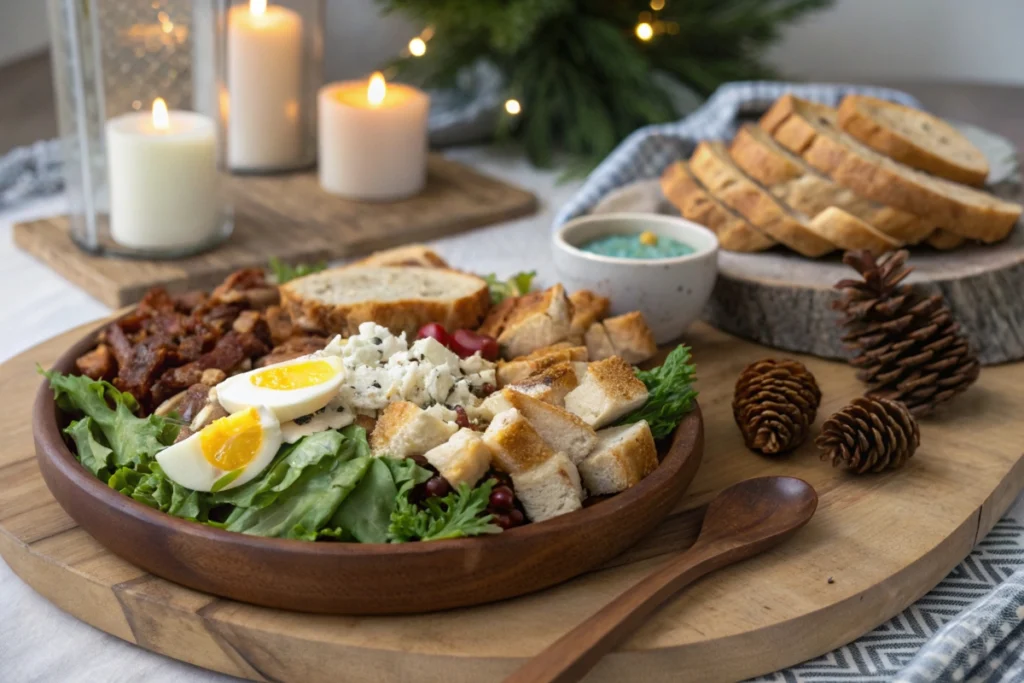
Before serving, drizzle your chosen dressing over the assembled salad, or serve it on the side to let guests dress their portions to taste. This salad pairs wonderfully with a warm, crusty bread or a simple soup for a complete meal. The combination of textures and flavors in the Winter Cobb Salad makes it a satisfying and impressive dish, perfect for both casual lunches and festive gatherings.
Nutritional Benefits of Winter Ingredients
Health Benefits of Ingredients in a Winter Cobb Salad
The Winter Cobb Salad is not just delicious—it’s also packed with nutrients. The winter greens like kale and spinach provide fiber, vitamin C, and antioxidants, which help support your immune system during the colder months. Meanwhile, roasted vegetables like butternut squash and beets are rich in beta-carotene, potassium, and other essential vitamins. Adding fruits like pomegranate seeds and pears brings a dose of natural sweetness along with vitamins A and K.
Proteins such as roasted chicken, tofu, or eggs supply the body with the building blocks it needs to stay strong and energized. The nuts, like walnuts and pecans, provide healthy fats that are good for your heart. Finally, cheese adds calcium and a touch of indulgence, rounding out the salad as a balanced and wholesome meal.
Dietary Considerations
One of the best things about the Winter Cobb Salad is its versatility. You can easily adapt it to fit your dietary preferences. Need a vegan version? Swap out chicken and cheese for plant-based alternatives. Gluten-free? Stick to naturally gluten-free ingredients, which are already the focus of this salad. No matter how you customize it, this salad is a nutrient-dense option to keep you fueled and satisfied.
Variations and Customizations
Vegetarian and Vegan Options
The Winter Cobb Salad is easy to modify for vegetarian or vegan diets. For a vegetarian twist, simply skip the chicken and bacon while keeping the eggs and cheese. To make it fully vegan, swap the eggs and cheese for roasted chickpeas or marinated tofu. You can also use a dairy-free cheese alternative to maintain the creamy texture and rich flavor.
Gluten-Free Adaptations
Luckily, most of the ingredients in this salad are naturally gluten-free. However, if you’re using store-bought dressings or seasoning mixes, double-check the labels to ensure they don’t contain hidden gluten. For added crunch, you can replace croutons with gluten-free options, like toasted seeds or gluten-free crackers crumbled on top.
The Winter Cobb Salad is a dish that can cater to almost any dietary need. It’s a versatile, colorful, and flavorful addition to your meal rotation, whether you’re serving it as a main course or a hearty side.
Why You Should Try a Winter Cobb Salad Today
A Seasonal Favorite Packed with Benefits
Did you know that winter salads like the Winter Cobb Salad are not only delicious but also a powerhouse of nutrients? Incorporating seasonal produce can boost your immune system during the colder months. For instance, winter greens such as kale and spinach are rich in vitamins C and K, while pomegranate seeds offer potent antioxidants that promote heart health and radiant skin.
Studies have shown that individuals who include leafy greens and seasonal vegetables in their diet experience higher energy levels during the chilly winter days. So, why not make the Winter Cobb Salad a staple in your weekly meal plan?
FAQs
A Cobb salad stands out due to its unique combination of ingredients and presentation. Traditionally, it features a mix of lettuce, grilled chicken, bacon, hard-boiled eggs, avocado, tomatoes, and blue cheese, all arranged in neat rows or sections rather than being tossed together. This structured layering, along with the variety of textures and flavors—crunchy greens, creamy avocado, and savory proteins—makes it different from most other salads.
Absolutely! Salads can be enjoyed year-round, including during the winter. Winter salads often feature hearty, seasonal ingredients like kale, spinach, roasted vegetables (butternut squash, beets), and fruits like pomegranates and pears. These ingredients provide a warm, comforting touch while maintaining the freshness of a salad, making them perfect for colder months.
Cobb salad can be high in calories due to its rich ingredients, like bacon, blue cheese, avocado, and creamy dressings. These components, while flavorful, are calorie-dense. However, you can make a lighter version by using leaner proteins, reducing cheese and bacon, or opting for a vinaigrette dressing instead of a creamy one.
Kim Kardashian is known for enjoying salads from a popular chain, and her typical salad includes a mix of fresh greens, turkey, egg whites, avocado, and a light vinaigrette. To replicate her style:
Use romaine lettuce or mixed greens as the base.
Add diced turkey or chicken breast for protein.
Include hard-boiled egg whites and sliced avocado.
Top it off with a light balsamic vinaigrette or oil-based dressing.
An Aussie Cobb salad often includes a local twist on the traditional recipe. It may feature ingredients like:
Mixed greens and spinach.
Grilled prawns or chicken as the protein.
Avocado, hard-boiled eggs, and cherry tomatoes.
Cheddar cheese (instead of blue cheese).
Roasted pumpkin or beetroot for a seasonal, Australian flair.
A tangy dressing, such as lemon vinaigrette.
This variation reflects Australian cuisine’s focus on fresh, seasonal, and vibrant ingredients.
Conclusion
The Winter Cobb Salad is a vibrant, nutritious dish that transforms the classic Cobb into a wintertime favorite. With its mix of roasted vegetables, hearty greens, fresh fruits, and protein-packed toppings, this salad is as versatile as it is delicious. Whether you’re making it for a cozy lunch or a festive gathering, it’s sure to impress with its bold flavors and eye-catching presentation.
This recipe celebrates the best of seasonal produce, ensuring every bite is bursting with goodness. Plus, it’s highly adaptable to suit different dietary needs, making it a great choice for everyone at the table. So, the next time you’re craving something fresh yet comforting, give the Winter Cobb Salad a try—it’s a meal you’ll keep coming back to all season long.
Certainly! Here’s the additional section tailored for an American audience, incorporating relevant internal links from Freshly Recipes
Why You Should Try a Winter Cobb Salad Today
A Seasonal Favorite Packed with Benefits
Did you know that winter salads like the Winter Cobb Salad are not only delicious but also a powerhouse of nutrients? Incorporating seasonal produce can boost your immune system during the colder months. For instance, winter greens such as kale and spinach are rich in vitamins C and K, while pomegranate seeds offer potent antioxidants that promote heart health and radiant skin.
Studies have shown that individuals who include leafy greens and seasonal vegetables in their diet experience higher energy levels during the chilly winter days. So, why not make the Winter Cobb Salad a staple in your weekly meal plan?
Explore More Seasonal Recipes
Looking to complement your meal? Check out our Hearty Lentil Soup recipe, which pairs perfectly with this salad. If you have a sweet tooth, our Classic Apple Pie makes for a delightful seasonal dessert.

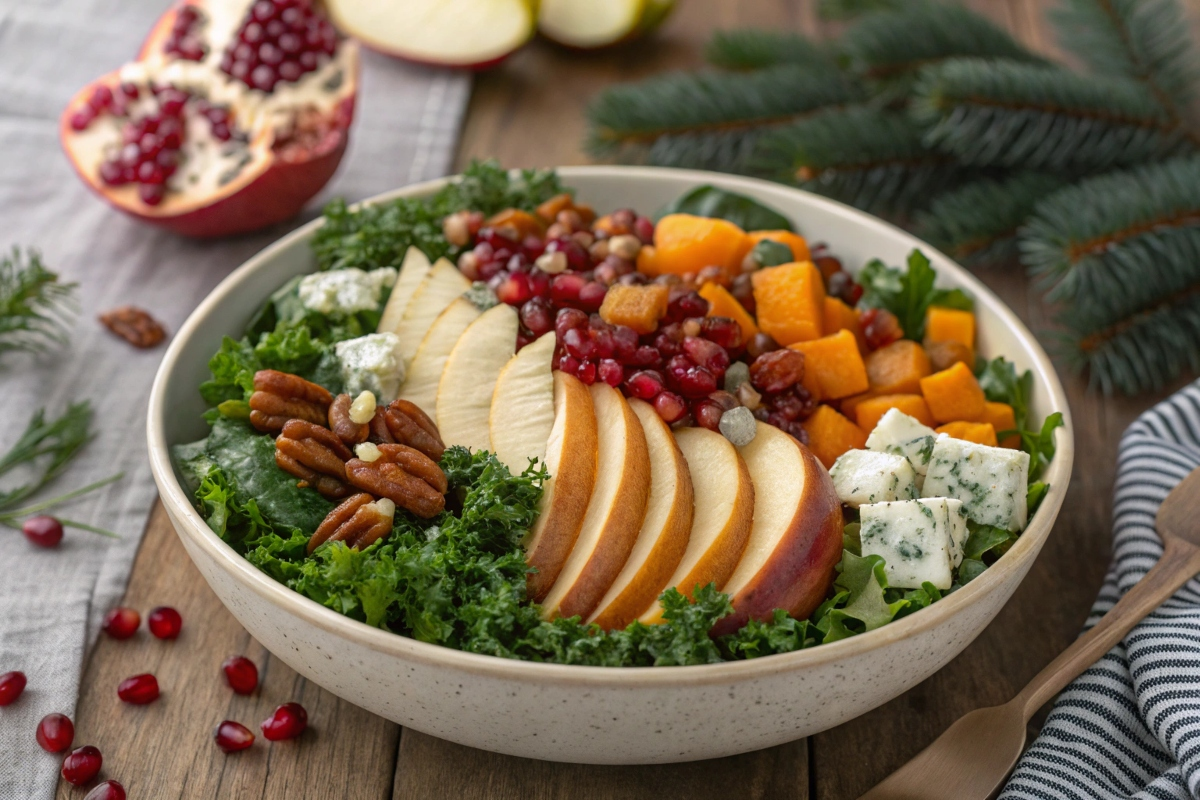
1 thought on “Winter Cobb Salad Recipe: The Best Hearty Lunch for Cold Days”